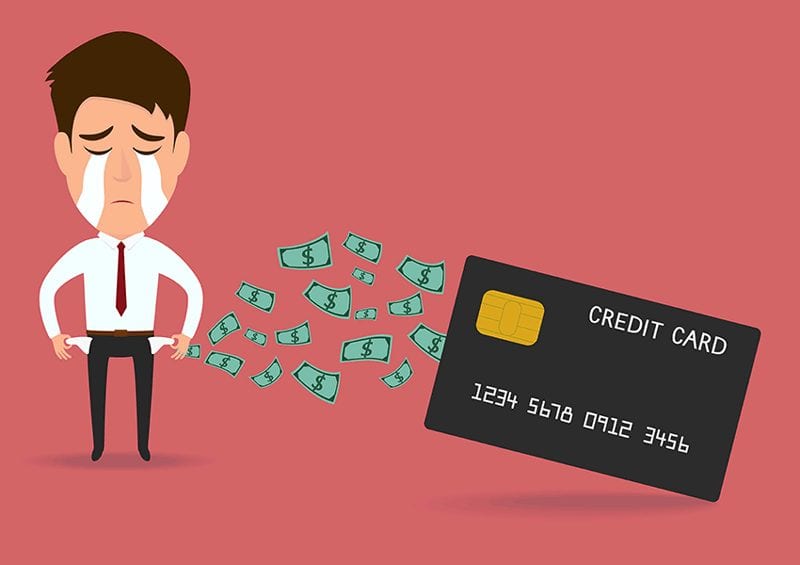Paying off high interest credit card debt can be accomplished by utilizing a mix of strategies. Among them: ceasing all unnecessary spending, requesting lower interest rates and paying as much as possible on the balance. Other methods also could be considered.
Why does this matter? Credit card debt is and has been on the rise. Prior to the COVID-19 pandemic, credit card debt increased from the second quarter (Q2) of 2015 to Q2 2019 by 31%, according to Experian.
The fallout from the pandemic and resulting shutdowns in 2020 caused a surge in borrowing. A September 2021 online survey of 2,400 U.S. adults by Bankrate found 42% of consumers with credit card debt have added to the amount they owe since the pandemic began in March 2020. That means those in debt increased their debt, and struggled to escape it.
When the average credit card interest rate in late 2021 is 16.6%, not addressing that debt will lead to it mushrooming. It’s important for financial well-being to address it, and if possible the interest rate.
1. Stop All Unnecessary Spending
When in debt, an important step is to stop spending on items you don’t need – otherwise known as discretionary spending – meaning you choose whether you really need it.
That extra 42” TV that you really don’t need? Don’t buy it. The jewelry that looks nice but will eat into your budget? Wait to buy it. The extra movie channel on the TV? Whittle it down to the one or two you watch. Don’t eat out. Stop smoking. Cut back on expensive coffees. Find a part-time job. By squeezing extra dollars out of your budget, you might be putting $100 extra (or more) toward that credit card bill. And that’s a good thing.
Necessary expenses like the mortgage, food, utilities? Of course you should pay those bills. Not doing so could lead to losing the house or having your power shut off. Nobody needs that. So, spend on necessary expenses, but cut out the discretionary spending and use that money to pay down your debt.
When it comes to spending, it also is wise to use cash only. This is simple logic. Adding more credit card debt only makes the burden heavier. It also will increase the total payment and interest payments.
Paying with cash means you are spending only what you have, not borrowing against what you don’t have. It will keep you from increasing your debt load and may make spending more reasonable. It’s a lot different to pull a $100 bill out of your wallet or purse than it is to put it on plastic, which can seem like it’s not even spending real money.
2. Ask for a Lower Interest Rate
Creditors will work with their best cardholders, especially if they pay on time and rarely miss a payment. If you’re getting offers for other credit card companies with lower rates, don’t be afraid to bargain a bit with your current card company.
One phone call can go a long way, especially if the credit card company feels like it may lose your interest payments.
3. Pay as Much as You Can
If you want to make any dent in the bottom line, you must increase the amount of your monthly payment. If you’re only making minimum payments, much of it goes toward interest and the balance doesn’t move much, if at all. Start with what you can afford, then try to build on that amount.
4. Balance Transfer
If you have $5,000 in credit card debt and you’re paying 18% interest with a $200 monthly payment — and you won’t inherit or earn an extra $5,000 any time soon — a balance transfer credit card could be an effective way to manage your debt.
A balance transfer means paying off the balances on existing cards or loans by transferring them to a new credit card account with a zero-percent interest rate. Generally, you need good-to-excellent credit to be approved, which means a score of 680 or above. You also might need to compromise. Even if you aren’t approved for the full amount, any little bit helps. It might require a transfer fee — typically 3% of the account — to complete the balance transfer but paying said fee could be worth it in the long run.
What’s the advantage? By shifting to a 0% deal on a new credit card, you save the 18%-25% interest you were paying. These cards have an introductory period of 12-18 months before they start charging regular interest rates of 16% or more.
It is vital to pay close attention to the terms of the new credit card. A zero-interest charge may require complete repayment over those 12-months. If you don’t meet that requirement, some credit card companies will “accelerate” those interest charges right back to your debt.
Pay attention when making this kind of decision. If you do and you meet the requirements, it can be a help.
If you can’t qualify for a 0% deal, there might be a low interest rate card or perhaps you can qualify to shift a portion of your debt.
» Learn More: Balance Transfer Credit Card vs. Personal Loan
5. Choose a Pay-Off Method: Debt Avalanche or Debt Snowball
The time-tested method of paying the debt down as fast as possible is always on the table. A “debt avalanche” means starting with the cards that have the highest interest rate and working your way down to lower interest cards. A “debt snowball’’ means paying off small debts first. Dispensing with a low-balance card debt serves as motivation to attack the high balance cards.
For some, getting rid of high-interest debt isn’t the best strategy, psychologically. It might be better to pay off some smaller balances, thus freeing up money to put toward that high interest rate debt.
For example, suppose you have a credit card with a $3,000 balance at 18% APR and another with a $2,000 balance at 12%. If you pay off the higher interest card within six months instead of 12, you’d save about $133 in interest. By contrast, targeting the lower interest card would save you just $62 in the same time frame.
Sometimes, the best strategy is to put all your extra money toward a single high interest rate debt. Once that is paid off, work on the next highest debt. Keep going — without using the freed-up money for more purchases — and you’re on the way to debt-free status.
6. If You Can Save Interest, Consider a Personal Loan
Another option would be to take out a personal loan. The key here is to make sure the interest rate on the personal loan is less than the interest rate on the credit card. If you can find a loan for 9% and the credit card is at 18%, you’ve cut your interest charges in half. If the best personal loan you can find is 16%, you may be better off simply paying extra on your credit card.
Some lenders may offer special rates in the 4-to-6% range. Any move that gets you way under the 18% rate is a victory.
7. Try Making Two Payments a Month
An alternative way to reduce the interest you pay is to make more than one credit card payment per month. If you can, increase the monthly payment to every card.
An added benefit of this strategy is that it can strengthen your credit score. You won’t be at risk of missing a payment, and you’ll reduce your credit utilization ratio, which is the amount of available credit in use relative to your credit limit. That’s the second most important factor in your credit score, after payment history.
8. Look Into Debt Consolidation or Credit Card Counseling
Nobody is alone in these situations. Enrolling in credit counseling with a nonprofit counseling agency can help you assess the best strategy. Credit counseling typically is free and involves talking with a certified counselor who assesses the situation and offers solutions that will best address your problem.
A 2016 study from the National Foundation for Credit Counseling found that 73% of those who sought credit counseling paid their more debts more consistently, and 70% improved their confidence in their financial situation.
» Learn More: How to Pay Off $40,000 in Credit Card Debt

7 MINUTE READ
Home » InCharge Blog »
Sources:
- McGurran, B. (2019, December 3) 11 Ways to Pay Off High Interest Credit Cards. Retrieved from https://bit.ly/3iw09KP
- Johnson, A. (2021, September 27) Poll: COVID-19 causes debt surge for some consumers. Retrieved from https://www.bankrate.com/finance/credit-cards/credit-card-debt-poll/
- Konish, L. (2021, September 27) 42% of Americans have racked up more credit card debt since Covid-19 began. These tips can help get that under control. Retrieved from https://www.cnbc.com/2021/09/27/42-percent-of-americans-have-increased-their-credit-card-debt-during-covid-19.html
- N.A. (ND) Pay Off Credit Cards or Other High Interest Debt. Retrieved from https://www.investor.gov/introduction-investing/investing-basics/save-and-invest/pay-credit-cards-or-other-high-interest
- N.A. (2021, September 24) The Benefits of Using a Credit Counseling Service. Retrieved from https://www.cccsofiowa.org/blog/2021/09/24/the-benefits-of-using-a-credit-counseling-service

















